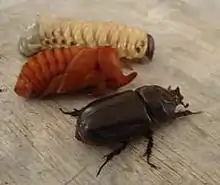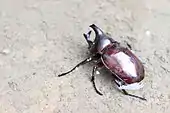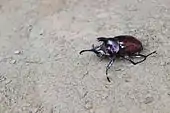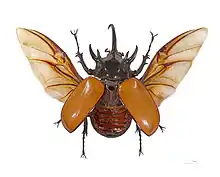Dynastinae
Dynastinae or rhinoceros beetles are a subfamily of the scarab beetle family (Scarabaeidae). Other common names – some for particular groups of rhinoceros beetles – include Hercules beetles, unicorn beetles or horn beetles. Over 1500 species and 225 genera of rhinoceros beetles are known.[1]
| Dynastinae | |
|---|---|
 | |
| Scientific classification | |
| Kingdom: | Animalia |
| Phylum: | Arthropoda |
| Class: | Insecta |
| Order: | Coleoptera |
| Family: | Scarabaeidae |
| Subfamily: | Dynastinae MacLeay, 1819 |
| Tribes | |
Many rhinoceros beetles are well known for their unique shapes and large sizes. Some famous species are, for example, the Atlas beetle (Chalcosoma atlas), common rhinoceros beetle (Xylotrupes ulysses), elephant beetle (Megasoma elephas), European rhinoceros beetle (Oryctes nasicornis), Hercules beetle (Dynastes hercules), Japanese rhinoceros beetle or kabutomushi (Allomyrina dichotoma), ox beetle (Strategus aloeus) and the Eastern Hercules beetle (Dynastes tityus).
Description and ecology

Larva (back), pupa (center), imago (front)
The Dynastinae are among the largest of beetles, reaching more than 15 cm (6 in) in length, but are completely harmless to humans because they cannot bite or sting. Some species have been anecdotally claimed to lift up to 850 times their own weight.[2] Their common names refer to the characteristic horns borne only by the males of most species in the group. Each has a horn on the head and another horn pointing forward from the center of the thorax. The horns are used in fighting other males during mating season, and for digging. The size of the horn is a good indicator of nutrition and physical health.[3]
The body of an adult rhinoceros beetle is covered by a thick exoskeleton. A pair of thick wings lie atop another set of membranous wings underneath, allowing the rhinoceros beetle to fly, although not very efficiently, owing to its large size. Their best protection from predators is their size and stature. Additionally, since they are nocturnal, they avoid many of their predators during the day. When the sun is out, they hide under logs or in vegetation to camouflage themselves from the few predators big enough to want to eat them. If rhinoceros beetles are disturbed, some can release very loud, hissing squeaks. The hissing squeaks are created by rubbing their abdomens against the ends of their wing covers. Rhinoceros beetles are relatively resilient; a healthy adult male can live up to 2–3 years. The females rarely live long after they mate.
These beetles' larval stages can be several years long. The larvae feed on rotten wood and the adults feed on nectar, plant sap and fruit. First, the larvae hatch from eggs and later develop into pupae before they reach adult status (see picture at left). The females lay 50 eggs on average. Contrary to what their size may imply, adult rhinoceros beetles do not eat large amounts, unlike their larvae, which eat a significant amount of rotting wood.
Mating
Male Japanese rhinoceros beetles, (Allomyrina dichotoma) fight to dominate sap sites. Males use their horns to pry rival males off the area, and gives them the chance to mate with the female. In this and other species that defend mating sites, larger males with larger horns mate more frequently, as they win more contests. Small males often avoid larger males and exhibit alternative strategies gain access to females.[4][5]
Interactions with humans
Use by humans
Rhinoceros beetles have become popular pets in parts of Asia,[6] due to being relatively clean, easy to maintain, and safe to handle. Also in Asia, male beetles are used for gambling fights.[7] Since males naturally have the tendency to fight each other for the attention of females, they are the ones used for battle. To get the two male beetles to lock in combat, a female beetle is used, or a small noisemaker duplicating the female's mating call.
Entomologist Séverin Tchibozo suggests the larvae contain much more protein (40%), than chicken (20%) and beef (approximately 18%) and they could become a protein source for a large human population.[8]
Dr. MinJun Kim, leading a team of engineers in National Science Foundation-funded research, examined the function and aerodynamics of Allomyrina dichotoma, with the help of researchers in Drexel University's Mechanical Engineering Department and in collaboration with Konkuk University in South Korea. Rhinoceros beetles could play a big part in the next generation of aircraft design.[9]
As a pest
Some species can become major pests, e.g., in tree plantations. Usually though, beetle population densities are not as high as in some other pest insects, and food trees which are typically already sick or dying from some other cause are preferred. Some species' larvae, however, will attack healthy trees or even root vegetables, and when they occur in large numbers, can cause economically significant damage. The fungus Metarhizium anisopliae is a proven biocontrol agent for beetle infestation in crops.
Tribes and Genera, with selected species
_%D0%BA%D1%83%D0%BA%D1%83%D1%80%D1%83%D0%B7%D0%BD%D1%8B%D0%B9.jpg.webp)


Agaocephalini Burmeister, 1847 (disputed)
- Aegopsis
- Agaocephala
Cyclocephalini Laporte, 1840
Dynastini
Auth: MacLeay, 1819
- Allomyrina Arrow, 1911 (including Trypoxylus)
- Allomyrina dichotoma – Japanese rhinoceros beetle
- Chalcosoma Hope, 1837
- Chalcosoma atlas – Atlas beetle
- Chalcosoma moellenkampi – Moellenkampi beetle
- Chalcosoma caucasus – Caucasus beetle
- Dynastes Kirby, 1825
- Dynastes hercules – Hercules beetle
- Dynastes neptunus – Neptune beetle
- Eupatorus Burmeister, 1847
- Eupatorus gracilicornis – Five-horned rhinoceros beetle
- Eupatorus siamensis – Siamese beetle
- Eupatorus birmanicus – Rabbit beetle
- Megasoma Kirby, 1825
- Megasoma mars - Mars beetle
- Megasoma elephas - Elephant beetle
- Megasoma actaeon - Actaeon beetle
- Xylotrupes Hope, 1837
- Xylotrupes gideon – Siamese rhinoceros beetle
- Xylotrupes ulysses
Hexodontini (disputed)
- Hexodon
- Hyboschema
Oryctini
Auth: Mulsant, 1842
- Coelosis Hope, 1837
- Coelosis bicornis
- Coelosis biloba
- Coelosis bourgini
- Coelosis denticornis
- Coelosis hippocrates
- Coelosis inermis
- Coelosis sylvanus
- Coelosis wayuorum[10]
- Enema Hope, 1837
- Heterogomphus Burmeister, 1847
- Megaceras Hope, 1837
- Oryctes Illiger, 1798
- Oryctes nasicornis – European rhinoceros beetle
- Oryctes rhinoceros – Asiatic rhinoceros beetle
- Strategus Hope, 1837
- Strategus aloeus – ox beetle
- Trichogomphus Burmeister, 1847
Oryctoderini
- Chalcocrates
- Oryctoderus
Pentodontini
Auth: Mulsant, 1842
- Bothynus Hope, 1837
- Diloboderus Sturm, 1826
- Pentodon Hope, 1837
- Pericoptus Burmeister, 1847
- Thronistes Burmeister, 1847
- Tomarus Erichson, 1847
Notes
- Beutel, Rolf G.; Leschen, Richard A.B., eds. (2016-03-21). Coleoptera, Beetles, Volume 1, Morphology and Systematics (Archostemata, Adephaga, Myxophaga, Polyphaga partim). De Gruyter. doi:10.1515/9783110373929. ISBN 978-3-11-037392-9.
- Rodger Kram: Inexpensive Load Carrying By Rhinoceros Beetles. The Journal of Experimental Biology 199, 609–612 (1996)
- "Why horn size matters when picking a mate". New Scientist.
- Buchalski, Benjamin; Gutierrez, Eric; Emlen, Douglas; Lavine, Laura; Swanson, Brook (2019-10-15). "Variation in an Extreme Weapon: Horn Performance Differences across Rhinoceros Beetle (Trypoxylus dichotomus) Populations". Insects. 10 (10): 346. doi:10.3390/insects10100346. ISSN 2075-4450. PMC 6835817. PMID 31618906.
- Goczał, Jakub; Rossa, Robert; Tofilski, Adam (2019-04-17). "Intersexual and intrasexual patterns of horn size and shape variation in the European rhinoceros beetle: quantifying the shape of weapons". Biological Journal of the Linnean Society. 127 (1): 34–43. doi:10.1093/biolinnean/blz026. ISSN 0024-4066.
- "WHO? KNEW" (May 6, 2005) Current Science Vol.90 No.16
- Rhinoceros beetle gambling in Thailand
- Global Steak - Demain nos enfants mangeront des criquets (2010 French documentary)
- "Engineers Unlock Secrets of Beetle Flight" (news story). ScienceDaily. April 11, 2012.
ScienceDaily (Apr. 10, 2012) — Rhinoceros beetles could play a big part....
- Neita-Moreno, Jhon César; Orozco, Jesús; Medina-Uribe, Claudia Alejandra (19 February 2018). "Description of a new species of Coelosis Hope from Guajira Peninsula, northern Colombia". ZooKeys (738): 67–80. doi:10.3897/zookeys.738.22273. Retrieved 3 April 2018.
Further reading
- Endrödi, S. (1985). The Dynastinae of the World. Series Entomologica. 28. Dr. W. Junk Publishers. ISBN 978-9061931386.
- Dechambre (R.-P.) & Lachaume (G.) The Beetles of the World, volume 27, The genus Oryctes (Dynastidae), Hillside Books, Canterbury
- Gutierrez, Eric et al. “Variation in an Extreme Weapon: Horn Performance Differences Across Rhinoceros Beetle (Trypoxylus Dichotomus) Populations.” Insects. 10.10 (2019): n. pag. Web.
- Goczał, Jakub, et al. “Intersexual and Intrasexual Patterns of Horn Size and Shape Variation in the European Rhinoceros Beetle: Quantifying the Shape of Weapons.” Biological Journal of the Linnean Society, vol. 127, no. 1, May 2019, pp. 34–43. EBSCOhost, doi:10.1093/biolinnean/blz026.
External links
| Wikimedia Commons has media related to Dynastinae. |
| Wikispecies has information related to Dynastinae. |

